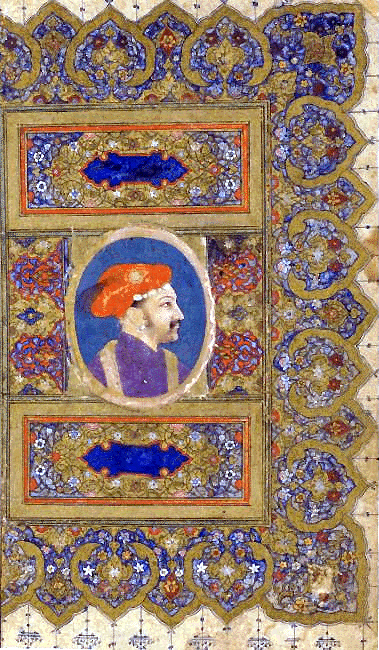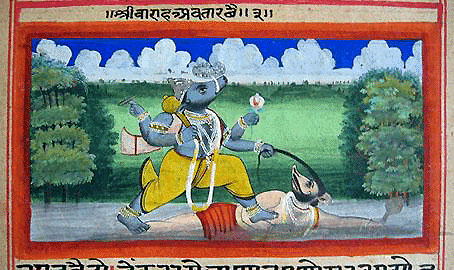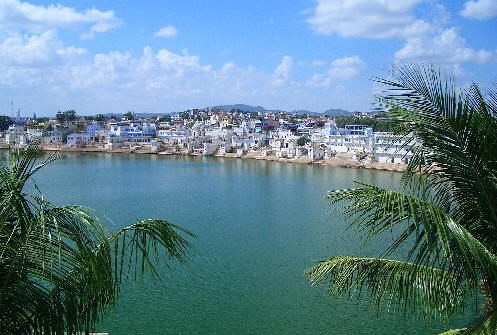
|
|
|
|
BY: SUN STAFF

Portrait of Jahangir Sep 27, 2010 — CANADA (SUN) — A serial presentation of the Mughal effect on Vaisnava society. In 1614 A.D., just nine years after seating himself as Emperor on his father Akbar's Mughal throne, Jahangir experienced a series of events in his life that supposedly caused him to become more religious. Once, having prayed for relief from severe fever and headaches, which abated, his religious sentiment is said to have increased. Jahangir was living at Ajmer at the time, taking shelter of the Sufis priests there in religious matters.
In a book entitled Nur Jahan, Empress of Mughal India by Ellison Banks Findly, we find some interesting references both to Jahangir's destruction of and dalliance with Vaisnava temples and sadhus. Nur Jahan, who was the twentieth and supposedly the favorite wife of Emperor Jahangir, became even more famous than her husband. Many of the good works that manifested during the time of Jahangir's court were due to the efforts of Nur Jahan. For that reason, many of her pastimes have been carefully documented, and also provide a good record of Jahangir's activities. In Nur Jahan, Findly describes a scene wherein Jahangir's behaviour is reminiscent of the demoniac behaviour of his predecessors: "Jahangir was not always kind to Hindu practice, however, and erupted once unexpectedly at a temple dedicated to Vishnu. In 1614, while walking around the temple grounds, he came upon "a form cut out of black stone, which from the neck above was in the shape of a pig's head, and the rest of the body was like that of a man." Disgusted by this image of Varaha, the boar incarnation of Vishnu, Jahangir began to rile against the "worthless religion of the Hindus," [95] and like a good Muslim and consistent with his earlier discussion with the pandits, [96] he went on to denounce the religion in which "the Supreme Ruler thought it necessary to show himself in this shape." Ever wary thus of idolatry, Jahangir then had "that hideous form" broken up and thrown into the tank. Seeing further that there was a white domed structure on a hill nearby where devotees flocked to visit a resident yogi, Jahangir, unable to control his anger when he heard that part of the worship was to put flour in the mouth and to "imitate the cry of an animal," had the building broken down, the yogi turned out, and the image inside destroyed. [97] Oddly consistent with the aesthetic dimensions of his character, however, Jahangir then inspected the building to confirm or deny the rumour that it had no bottom. The building did have a bottom, however, and being Jahangir, he measured it. [98] This incident, sadly prophetic of Shah Jahan's later destruction of Hindu idols and temples, [99] was indicative less of Jahangir's disdain for Hindu practice – of which, in fact, there seems to have been very little – and more of his easily offended aesthetic nature. His main criticism of Hinduism was its idolatry, [100] and his main criticism of idolatry was not a theological abhorrence of giving the unknowable form, but a visual repulsion at the specific form this particular phenomenalization took. Unable to bear what didn't please his eyes, Jahangir destroyed, but in the act of this destruction, he unwittingly upheld the iconoclasm of the faith of his forefathers."

Lord Varaha This passage by author Ellison Banks Findly raises a number of issues. First, let us remember that what distinguished Jahangir – from well before Akbar's departure -- was his lifelong debauchery with alcohol and other forms of highly excessive sense gratification. He was so addicted that it eventually brought on his death. Yet Findly characterizes Jahangir as an intelligent, thoughtful man of classical tastes – even as a pious Muslim. To say that Jahangir destroyed Lord Varaha's Deity and temple "like a good Muslim" supposes that he was one. But how many pious Muslims have died of alcoholism? On one hand, Findly suggests that the Emperor's Muslim sentiments against idolatry were riled, but then he contradicts it, saying it was actually Jahangir's personal ascetic tastes that were offended. The report that Jahangir inspected the Varaha temple ruins at Pushkar to confirm it did have a bottom, contrary to local belief, is typical of the behaviour of invaders. There is always an effort made to debase the local citizens' faith in their spiritual, and secular leaders, so they will surrender more readily to the new wielders of power. So the degree to which Jahangir was moved to destroy Lord Varaha's Deity and temple because of religious sensibilities seems highly questionable. That he would destroy the deity and temple as a show of power… that seems much more likely.

Pushkar Findly's comment that this incident was "sadly prophetic of Shah Jahan's later destruction of Hindu idols and temples" is rather strange. The history of his predecessors, from Babur to Humayun to Akbar, is that they all engaged in destroying temples and killing the Hindu citizenry. All of them exemplified the sort of demoniac behaviour Jahangir did, in disparaging Lord Varaha and throwing Him to the bottom of the tank. All were prophetic of Shah Jahan's pastimes. Jahangir's acts would only merit being called "prophetic" if he had himself broken the legacy, and stopped such destruction, being followed in like kind by Shah Jahan. But that is not how the story goes. The real story is that shortly after taking the throne, Jahangir dismissed the peace treaty that was in place, and vigorously renewed the Mughal war against Mewar. In 1614, the very year Jahangir was praying to Allah for relief from his sickness and headaches, his 32 year-old son, Prince Khurram, was busy sacking villages, destroying crops, orchards and forests, razing Vaisnava temples to the ground, and generally causing great distress to the citizens of Mewar. All this, under the leadership of a man who supposedly destroyed Lord Varaha's temple because the deity 'offended his aesthetic sensibilities'.
| |